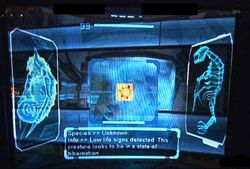The E.C.H.O. Visor (Electrosignetic Caphsronis Hectron Obenexer), was a high-tech signal visor created by a precise and complex three-fold combination of black market, stolen Imperial and Rebellion technology. It utilized the absolute peak of technology during its time, which also accounted for its rarity, complicated features, and especially its infamous expense. To ensure that it would never burn out or decrease in effectiveness, the E.C.H.O. Visor was energized by two small Artusian crystals located near the Visor's left and right temples.
The maintenance of the Visor was almost non-existent. The only regular maintenance required was that the two Artusian crystals in the visor’s temples needed semi-regular activation, in order to keep the crystals active and functioning. If the crystals are not powered up at least once every forty standard days, the crystals would steadily deteriorate.
Contrary to what most in the Rebellion believed, the Rebel Alliance splinter faction called Rebel Alliance Intelligence Faction (RAIF) was, in fact, behind the Visor’s creation. The technology was acquired almost completely by theft, assassination or sabotage, and several officials overseeing the creation of the Visor even hired several foreign scientists from another manufacturer. Due the organization's secrecy, the "publicly accepted" way the Rebel Alliance received the technologies was by using a sort infiltrator droids to simply copy the schematics from the Galactic Empire, and an unknown criminal entity.
Characteristics[]
Primarily created for the aid of sabotages, assassinations, or kidnappings, these were used by only the best of Rebel marines and infiltrators, though they were given to war heroes. The E.C.H.O. Visor was a near perfect detection device, able to see through heat, sound, and visibility hampering devices. Its secret wasn't actually by seeing through the devices themselves, but was by tapping into and reading the devices' electromagnetic signature—a feat once believed impossible. Once siphoned, the Visor would be able to "phase" through the cloaking devices, rendering them useless to the Visor's vision. The E.C.H.O. Visor was exceptionally expensive to produce, a large part of the reason for its rarity.
The general cost for its three-fold binding technology estimated to a retrieving cost of around 650,000 credits per pair, although it wasn't uncommon for its costs to escalate to a high 1,500,000 credits. That being said, for five pairs of E.C.H.O. Visors would required vast funds of at least 3,500,000 credits, and worst case scenario, up to 7,500,000 credits. Because nearly ten million credits for a mere five pairs—not including the installation fees and costs—would be necessary, E.C.H.O. visor were stored in safes and heavily guarded until put into use. The E.C.H.O. Visor had three signal channels or phases. However, these are not all active at the same time to avoid technical confusion and mishap.
The Three Channels[]
- Phase I, the primary phase, known as the signature phase—"saw" through virtually any visual or signal repellent or hampering device. This channel could detect targets using any kind of modified stealth field generators, including heat and sound. The target appeared through "sonar images" or "supersonic detection", giving the exact location of the target. Because the target was revealed through supersonic detection, the user literally saw the sound through artificial vision—creating an effective echo-like appearance. This echolocation feature is what gave the Visor its name. When in this phase, the Visor glowed dark red.
- Phase II, the second phase, known as the x-ray phase—allowed the user to phase through solid objects of a 300 meter radius. This phase was especially helpful for finding targets hiding in mattered objects, instead of cloaking devices. If the user was looking for a specific target or object, instead of searching blindly, they could pre-upload the information of the object to a memory bank near the bottom of the Visor. When an object is found matching the information uploaded, the object would glow more luminously than normal. The user's surroundings while using the Phase II of the E.C.H.O. Visor had a clear, glazed look about, for safety that the user didn't collide into any obstacles while in this channel. When in this phase, the Visor glowed blue.
- Phase III, the final phase, known as the identification phase—could scan humanoids for identification, even if unregistered. This phase signaled all data on the humanoid from nearly 20,000,000,000 galactic, private, military, and unofficial databanks until any sort of information on the humanoid was detected. Traditionally, this channel was used in kidnapping or other similar activities. This channel of the Visor was updated constantly every eight to twelve hours and houses billions of identification files. Consequently, this was the most expensive and complicated addition to the E.C.H.O. Visor. When in this phase, the Visor glowed white.
History[]
Technology Theft[]

The inside look of the E.C.H.O. Visor during Phase I
In 1 ABY, the Rebel Alliance Intelligence Faction had news of a nearly forgotten laboratory on Fondor that specialized in signal devices. A four man scientist team working for the Empire had completed a breakthrough formula for detecting signals and siphoning them with echolocation. The formula had taken twelve years to accomplish, but the Empire hadn't discovered to adapt them for military use at the time. During the night, Akar Division operatives had broken into the laboratories of the Empire, and stole the schematics for a new signal detection device, as well as the prototype device. To ensure no traces were left, they blew up the entire facility, along with the scientists.
Near the dawn of 2 ABY, the Zann Consortium's black market had one of nine prototype devices that illegally hacked into all known databases: galactic, private, unofficial, and military. At the time, Vzen Division RAIF operatives, impersonating Rebel representatives, had arrived to haggle for the technology. The auction was interrupted by the work of Imperial infiltrators. The area where the auction took place was bombarded by a showers of turbolasers. Desiring the technology, a Rebel guard was ordered to attempt to steal the unique scanner which was protected inside a durasteel container. By the time he had arrived at the stand, the visor was gone. Another buyer had stolen it and headed towards the starpads. By the time the buyer had reached his ship, it was bombed, and the explosion had launched him through a building. After a short search, the Rebels found the case, and retreated from the premises.
Birth of the Prototype[]
By the time Rebel scientist had perfected their x-ray phasing technology, the thoughts of combining all three technologies was exhausting. Being a neutral company, RAIF had hired some Xechsci Tech scientist to briefly work for the Rebellion in hopes to speed up the process. By late 2 ABY, the non-stop efforts by Rebel scientists and technicians had finally paid off. A reliable schematic had revealed itself, and the formula was on the mark. Construction had begun the next day.

The inside look of an E.C.H.O. Visor during Phase II
For eight months, the technicians had worked hard with the scientist on the task at hand. Two months later, a celebration was held in a secret Rebel facility on Corellia. Strict work had paid off, and all tests had succeeded expectations. Due to the success, one other facility had been given a copy of the schematics to work on. It had been given a name due to its capabilities: Electrosignetic, Caphsronis, Hectron, Obenexer. Because it was adapted into a visor, it was known as Codename: E.C.H.O. Visor.
Rarity of use[]
Though a remarkable device, the cost and time of constructing them was a considerable hinder to who received them. During the Battle of Shezyll, the E.C.H.O. Visors were finally put into action, and had served their purposes well. When ready, twenty were sent to Marshal Jaken Suons, then given to the newly formed Phantom Team. They were the first team in all of the Alliance to use them at all, and the Visors themselves were stored until they were actually going to be put into use to avoid unnecessary damage. Only war hero Major Krad Erron was known to have been given one for personal use, though the Alliance later revoked his right to keep it.
Growth and declination of production[]
Used only by the creators, the Rebellion Alliance, these eventually found their way to special units of the New Republic soldiers. Because they took roughly a year (approximately 10 months) of careful handmade concentration to correctly construct, they were, understandably, once in rare supply. As the New Republic grew, the amount of scientists they could fund to keep increased. The production numbers reached nearly 20,000 individual units, until the Yuuzhan Vong War came.

The inside look of the E.C.H.O. Visor during Phase III.
The worlds with the scientific facilities funded for that production were dominated by the Yuuzhan Vong—worlds like Fondor, Dantooine, and Coruscant. With the primary factories—along with their schematics—decimated during the war, fewer than 500 visors existed at the war's end. Extremely rare after the war, few knew who held one of the remaining E.C.H.O. Visors. By 1,100 ABY, they were believed to be extinct of use. Only two pairs were known to even be existing in the galaxy at that time:
- The first one, production code #17,187, was hidden deep in a secret Steel Legion vault. The actual location of the vault was never known.
- The second, production code #13,976, was located in a Coruscant museum for rare and exotic weaponry.
Behind the scenes[]
The E.C.H.O. Visor was heavily inspired, though not based upon, the Echo visor, Dark visor, and Scan visor of the Metroid video game franchise, specifically, Metroid Prime and Metroid Prime II: Echoes.
The E.C.H.O. Visor was originally intended to have only one phase, which is currently known as the first phase. The two additional phases were brought in some time later as additional channels. The x-ray channel was brought in because of the first picture fitting the description of an x-ray look, rather than a sound. The last phase was thought up about a month later. It nearly didn't make it to the article, because of unsatisfactory screen shots. It was added when a sufficient one was found.
The visual designs of the Visor itself were influenced by the scanner present at the Black market auction. Due to the "T" shape of the visor and the Zann Consortium's connection to Mandalore, the root of the E.C.H.O. Visor's appearance was, undoubtedly, Mandalorian. Later versions of the E.C.H.O. Visor could be adapted to any kind of helmet visor, however.
The E.C.H.O. Visor had a very minor crossover mention with the mercenary and bounty hunter, Ontuse Karaane, who managed to kill a pre-Espa Division operative that was taking on a special ops mission for their final stage of training. Due to the Espa Division's use of the E.C.H.O. Visor, Ontuse Karaane was able to make use of it during his missions.
Appearances[]
- Star Wars: Blood of Mandalores: Genocide of War I
- Star Wars: Blood of Mandalores: Genocide of War II
